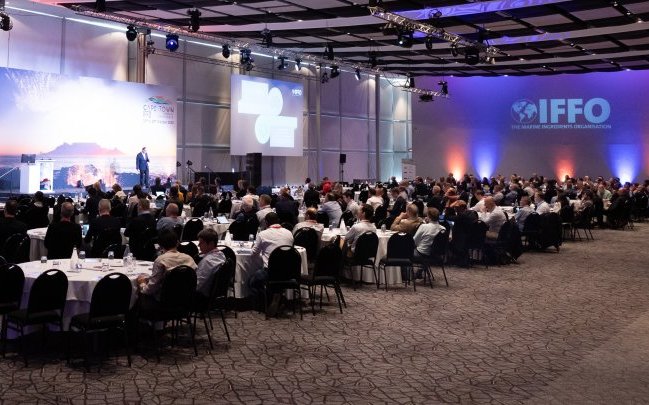This year, the marine ingredients industry has united for IFFO’s Annual Conference that was held in Cape Town with 395 delegates attending from 39 countries. Across three days, the agenda featured key players from both marine ingredients and related industries, discussing market trends and wider opportunities and challenges. Delving further into the strategic use of marine ingredients, technical experts explore precision nutrition, feed footprints, traceability as well as market trends.
Fishmeal market
In 2022, India's exports have increased dramatically pushing the country to become the fourth-largest exporting country, according to IFFO’s market research director, Enrico Bachis. Vietnam's exports also made great strides, while Peru's shipments decreased due to La Niña.
In terms of imports, the farming countries lead, with China being the biggest importer. Moving to consumption, there was growth in all sectors, with aquaculture continuing to take the lion’s share. As for species’ breakdown of global fed aquaculture, the dominant species in 2022 were carp, followed by crustaceans and freshwater fish (mainly farmed in Asia and China).
Fish oil market
Exports were led by Peru in 2022, although with a smaller share compared to 2021 on the back of a smaller production, Bachis reported. For imports, consistent trends from previous years with Norway being the biggest importer again in 2022.
In terms of fish oil usage, aquaculture is taking the bulk with more than 70% followed by nutraceuticals and pet food. By species, salmonids remained the largest consumers, with Europe being the largest consumer of fish oil. In human consumption, there was a growth of 4% in fish oil used by the pharmaceutical sector, with North America being the largest consumer. The other large consumer is pet food which slightly increased again in 2022.
Chr. Holtermann managing director, Christian Meinich, gave an outline of the fish oil markets and likely future developments. He noted that prices have continued in a climb pattern, but recently flattened out, caused by reduced fishing in Peru but high production from mackerel in Scandinavia and Iceland has acted as a counterbalance, but it’s unclear if this balancing act will last.
“Stocks remain tight for omega-3 grade oils, due to this reduced supply from Peru, but stocks for feed grade oils are sufficient thanks to supply from Scandinavian/Icelandic mackerel. There is potential for oil stocks to improve later in the year, depending on fishing in Peru. A recent trend of note is signs of a growing two-tier market in feed grades depending on sustainability, with certified vs. non-certified oils,” Meinich said.
Insights from China
IFFO’s China director Maggie Xu reported that for marine ingredients consumption in China, there have been the combined challenges of oversupply and financial loss for both the pig and aqua sectors. Fishmeal inclusion rates in both aqua and piglet diets were lowered in response to sluggish farm gate prices and tight fishmeal supplies. However, future growth points are in land-based RAS, off-shore farming, and most notably the vannamei shrimp market.
In terms of China’s marine ingredients output, the current fishing season is not very promising, with a reduction in tilapia byproducts due to low volumes of farming and processing. Fishmeal production in China might be slightly lower compared to 2022 which was at 345,000 mt. The lower supply of marine harvested whole fish might be compensated partially by imported sardine and frozen fish for human consumption. Fish oil outputs however are expected to grow in 2023, with an increased supply of whole fish for direct human consumption and increased imports from Russia.
In terms of fishmeal imports, it has slowed down with the high season of the country’s aquaculture industry. Imports from India and Vietnam have been leading in response to reduced imports from Peru, followed by Mexico and Chile. Imports of fish oil to China have dropped, with the exception of Morocco, which tripled its exports to China at the start of this year.
In terms of fishmeal consumption, China’s aquaculture industry was the main consumer at 89.6%, with the pig sector consuming the majority of the rest. For fish oil consumption, aquaculture again led to consuming 68.4%.
Looking at the aquafeed sector in China, the industry faced an overall loss and oversupply and prices of aquaculture products remained low, but this is pushing the sector to focus on innovation and business viability.
Precise nutrition
Fishmeal and fish oil supply have been stable over the last few decades and are now seen as strategic/functional ingredients as they bring benefits beyond the coverage of nutritional requirements. Marine ingredients are often used in the early growth stages, but this fluctuates from region and species.
“The industry needs to continue refining its optimization of nutrient specifications and targeting those ingredients that bring benefits beyond the basic nutrient supply. This includes increasing the range of ingredients available and focusing on more efficient feeds by more precisely defining what animals need. The industry needs to do better with the existing resources, and focus on emerging trends and rising challenges,” said Jorge Dias from Sparos.
Aquafeed costs are now the biggest challenge for farmers (around 50-65% of total investment), leading to aquafeed manufacturers having to adapt to the situation by considering or reconsidering alternative and additive ingredients, said Olivier Decamp, INVE Aquaculture, while discussing the challenges faced by shrimp farmers. Dietary changes can include increasing protein content in the early larval stages, using diets with lower protein content, revising fishmeal inclusion rates and varying the fishmeal sources.
“It is a challenge to find fishmeal alternatives as it delivers a unique mix of protein and nutrients. The way forward is to improve production efficiency, and profitability, by providing the right feeding protocol with the right combination of feed (including probiotics), while adapting to the shrimp stage and rearing protocol, such as shrimp stocking density, farm infrastructure or target harvest size,” Decamp said.
Sustainability
Understanding where and how seafood is produced is crucial to verify the status of those raw materials in relation to laws on food safety and production practices. But this information is also critical for the LCA story as raw material origin plays a big part in how environmental burdens are allocated. “We need to first define what sustainability is and decide on what we want to achieve first. Sustainability is a journey, not an endpoint and saying that something is sustainable can limit further improvements,” said Wesley Malcorps, Institute of Aquaculture of the University of Stirling.
In order to calculate the carbon footprint, water footprint, and all the other footprints required as part of the LCA process, data is needed from various stages in the ingredient production process, including catching, transport, processing and storage. The information required includes such details as the types of vessels used, their construction, the use of refrigerants, and fuel used in the fishing operation, and this is all before considering what happens once the fish comes ashore for the fishmeal and oil production process. “Marine ingredients have a low carbon footprint compared with terrestrial ingredients. However, we need a more holistic view taking other parameters into account, such as biodiversity impacts,” said Jorge Diaz Salinas from Skretting.
Increasingly, companies across all sectors are being requested to understand, address and report on the environmental, social, governance (ESG) risks and opportunities affecting their business, and fully consider the impacts of their business on the economy, people and environment. In many jurisdictions, reporting on ESG risks, opportunities and impacts is becoming mandatory, while across the world the rising profile of ESG issues is impacting financial investment decisions, with inflows into sustainable funds increasingly prioritized.
Salmon is seen as being very focused on carbon footprint, but the feed ingredients make up ¾ of their total footprint. Certification of ingredients is seen as a relevant way to provide customers with sustainability assurances. “There is a strong focus on novel ingredients. The shrimp sector, 50% larger than salmon in value globally, is lagging salmon in ESG terms, but will likely follow suit as it increasingly gets more industrialized,” said Ann Hvistendahl from DNB.
“Undoubtedly, the story around feed ingredients has very much been a story about volumes. With 40 million tonnes of additional volumes of feed ingredients needed by 2030, no replacement is happening. Supplementation is happening. Now, there is a need to set the sustainability agenda. We are setting it. Because a value chain approach to sustainability is critical to long-term business success, resilience and the industry’s license to operate. Customers, consumers, investors and civil society organizations will hold us responsible for any ESG discrepancies across the marine ingredients value chain, even if these originate from one of our suppliers,” said IFFO’s director general, Petter Martin Johannessen.










